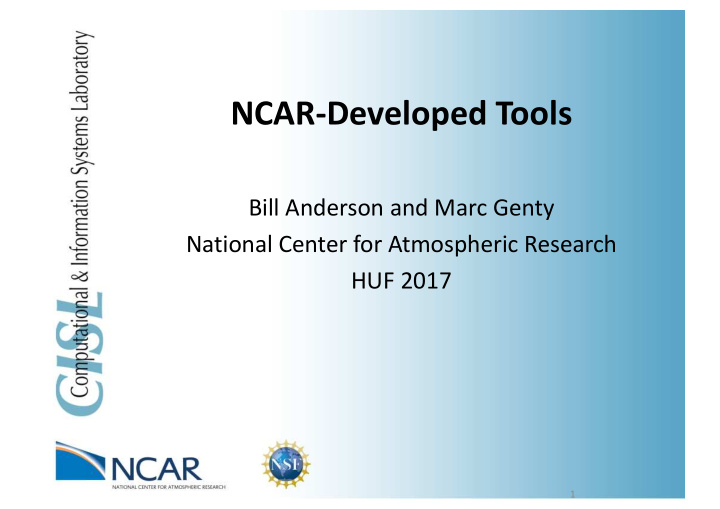



NCAR-Developed Tools Bill Anderson and Marc Genty National Center for Atmospheric Research HUF 2017 1
Introduction • Over the years, we’ve benefited from tools that others have developed • In this talk, we’ll share information about tools we’ve developed 2
Implementation Goals • simplicity • portability • scalability 3
Tools • tapeinfo • checkForMigration • Nagios 4
tapeinfo • Need for tape info in an easy-to-use tabular form • dump_sspvs, etc. help, but not all info • hpssadm.pl “Cartridges and Volumes” output not tabular • Also, helpful to have library location info 5
tapeinfo • Combines info from hpssadm.pl and ACSLS • Two components: script that gathers and merges data once a day • via cron and stores output in a file command line tool that displays that data as • tabular output 6
tapeinfo • Estimate compression ratio 7
tapeinfo • Tapes associated with a file family • Cold tapes 8
tapeinfo • Tape distribution across libraries 9
tapeinfo • Simple : A couple of hundred lines of python code • Portable : standard interfaces (hpssadm.pl and ACSLS cmd) • Scalable : Runs with thousands of tapes 10
checkForMigration • A need to find out which files have not yet been migrated from disk to tape • When upgrading Linux on movers, wanted to ensure all files had a tape copy • When something goes wrong with a RAID logical volume, need to know which files and how many are unavailable 11
checkForMigration • Example run: # checkForMigration 12345600 /home/smith/file1 not on tape /home/smith/file2 not on tape /home/smith/file3 not on tape 12
checkForMigration • script first runs ‘lsvol’ to get a listing of files • script then invokes a C client API program that checks if files have a copy on tape 13
checkForMigration • Client API program is 25 lines (including comments): rc = hpss_FileGetXAttributes(path, API_GET_STATS_FOR_LEVEL, 1, &AttrOut); if (rc == 0) { if (AttrOut.SCAttrib[1].VVAttrib[0].PVList == 0) { printf(“%s not on tape\n”, path); } } 14
checkForMigration • S imple: ~100 lines of code (C and bash) total • Portable: uses client API • Scalable: can check a disk volume with 300,000 segments in ~20 minutes 15
Nagios • Open source software for monitoring • Executes standard and custom health check scripts on remote hosts • Many alert and reporting features 16
Nagios • Used to augment existing tools • Two components: Code added to existing tools to create a Nagios • status file Standard Nagios service check script in libexec • to query the status file and report results • Existing tools continue to run out of root or ACSLS crontabs • Nagios checks do not require elevated privileges 17
Nagios – Augmentation Code COUNT=`${GREP} Degraded acsss_event.log|grep -v ^Cannot \ |wc -l|tr -d " "` if [[ "${COUNT}" -gt 0 ]] then ${GREP} Degraded acsss_event.log > ${MSG} diff ${MSG} ${DEGFND} 1>/dev/null 2>/dev/null if [[ $? -ne 0 ]] then echo "[CRITICAL] - SL8500 Degraded Components Found!" \ > /tmp/ck.degraded.nagios.out fi else echo "[OK] - No SL8500 Degraded Components Found." \ > /tmp/ck.degraded.nagios.out fi 18
Nagios – Service Status Check Code STATUS="/tmp/ck.degraded.nagios.out" grep "\[OK\]" ${STATUS} 1>/dev/null 2>&1 if [[ "$?" -eq "0" ]] then cat ${STATUS} exit 0 fi grep "\[CRITICAL\]" ${STATUS} 1>/dev/null 2>&1 if [[ "$?" -eq "0" ]] then cat ${STATUS} exit 2 fi echo "[UNKNOWN] - Status File Missing Or Logic Error!" exit 3 19
Nagios • Simple: Uses existing tools with minor modification & trivial Nagios service check code • Portable: Any cron, any language, any tool type, any operating system • Scalable: Nagios service check code leverages existing crontab entries (root, ACSLS, etc.) to minimize performance impact on the servers 20
Conclusion • tapeinfo • checkForMigration • Nagios 21
Thanks! Questions? 22
Recommend
More recommend